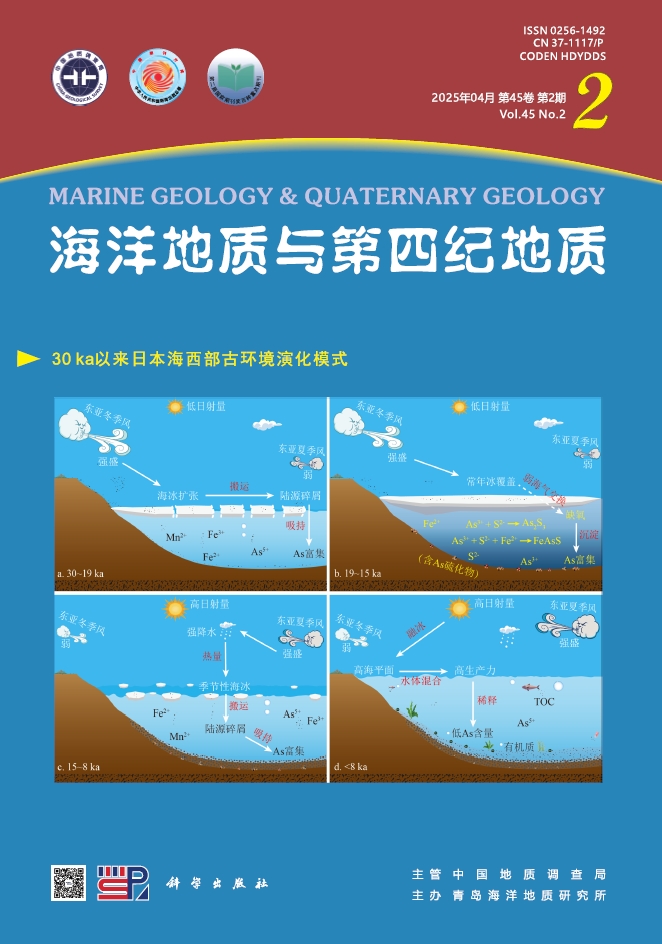| Citation: | GENG Shufang, LIU Ping, KOU Caihua. DEEP GEOLOGICAL STRUCTURE CONSTRAINTS ON SHALLOW GEOLOGY AND MINERALIZATION: A STUDY IN THE LAND AND SEA AREAS OF EAST CHINA[J]. Marine Geology & Quaternary Geology, 2014, 34(6): 49-61. doi: 10.3724/SP.J.1140.2014.06049 |
DEEP GEOLOGICAL STRUCTURE CONSTRAINTS ON SHALLOW GEOLOGY AND MINERALIZATION: A STUDY IN THE LAND AND SEA AREAS OF EAST CHINA
-
Abstract
Based on the research of the 3D Model of Lithospheric Structure supported by the international cooperation mapping project among China and surrounding countries, and the comprehensive analysis and study of deep geological structures, shallow geology and mineralization, the authors proposed the following ideas in this paper:① up to the depth of 400 km, in the land and sea areas of East China, there are five tectonic layers. The variations of the third and fourth layers constrains the shallow geology and mineralization; ②The land and sea areas of East China are under the squeezing pressure from surrounding areas, in which the pressure from the west dominates, resulting in the accumulation of great amount of asthenospheric materials and the formation of a large thermal energy and dynamic region. As the result, the forth power area is formed in the Asian Continent; ③the suduction of the Pacific Block ends at the latitude of 42°40'N along the Wandashan Mountain and the Far East of Russia, while the subduction of the Philippine Sea Block ends along Taiwan and Southeast coastal area of China. The joint action of the above-mentioned two forces drives the asthenospheric materials flowing to the Eastern sea area; ④the huge amount of energy from the asthenoshere, and the dynamic effect derived from the movement caused the formation of seven geological and morphologic features and three kinds of mineral resources in the land and sea areas of East China. The relationship between magmatism and the fossil fuel resources, such as petroleum, natural gas and coal, is not always negative. Magmatic activities may provide important thermal conditions necessary for oil-gas maturation, coalification and metamorphism; ⑤the huge amount of energy from the asthenosphere as well as its dynamic effect, may bring about some unique geological effects in the land and sea areas of East China; a, formation of some Cenozoic small oceanic basins, which have subducted to the Palawan Island; b, formation of some Cenozoic continental margin rift belts and the formation of the Qiongzhou Strait and Taiwan Strait, and the slight subduction towards the Taiwan Strait; c, the enormous accumulation of the asthenospheric materials caused the formation of a "giant Magmatic Mountain", which is in fact the source and foundation of the mantle plumes in the land and sea areas of East China. Each mantle plume is the peak of the Magmatic Mountain. It is believed that more mantle plumes or Magmatic Mountain peaks will be discovered in the future; d, except the deep earthquake (540 km) happened in Huichun of Jilin Province, most of the earthquakes in the Eastern China, as well as those occurred in Korean Peninsula and to the west of it in the land and sea areas of East China are mainly shallow and intermediate ones (<100 km), the main energy of which is from the giant thermal accumulation, the source of the earthquakes and the subduction of the Pacific Block and the Philippines Sea Block only play a limited role as a supplement to provide remote stresses; e, The giant thermal energy and dynamic movement results in a series of basin-mountain coupling belts in the land and sea areas of East China. There are energy resources in basins, and mineral resources in mountains. -

-
References
[1] 李廷栋,袁学诚,肖庆辉,等.中国岩石圈三维结构(上、中、下卷)[M]. 北京:地质出版社,2013.[LI Tingdong, YUAN Xuecheng, XIAO Qinghui, et al. 3D Model of Lithospheric Structure in China Series (Upper, Middle, Lower)[M]. Beijing:Geological Publishing House, 2013.] [2] 李廷栋,耿树方,范本贤,等.1:250万北-中-东亚及邻区地质图[M]. 北京:地质出版社,2012.[LI Tingdong, GENG Shufang, FAN Benxian, et al. 1:250 Million Geological Map of Northern-Central-Eastern Asia and Adjacent Areas[M]. Beijing:Geological Publishing House, 2013. ] [3] 耿树方,范本贤、易荣龙,等.1:250万北-中-东亚及邻区能源矿产(石油、天然气、煤)成矿规律图[M]. 北京,地质出版社,2012.[GENG Shufang, FAN Benxian, YI Ronglong, et al. 1:250 Million Minerogenic Map of Energy Resources in Northern-Central-Eastern Asia and Adjacent Areas (Oil, Gas and Coal)[M]. Beijing:Geological Publishing House, 2012. ] [4] 朱介寿,蔡学林,曹家敏,等.中国华南及东南沿海地区岩石圈三维结构及演化[M].北京:地质出版社,2005.[ZHU Jieshou, CAI Xuelin, CAO Jiamin,et al. 3D Model and Evolution of Lithospheric Structure in South and Southeast Coast of China[M]. Beijing:Geological Publishing House, 2005.] [5] 袁学诚.再论岩石圈地幔蘑菇云构造及其深部成因[J].中国地质, 2007, 34(5):737-758. [YUAN Xuecheng. Mushroom structure of the lithospheric mantle and its genesis at depth:revisited[J]. Geology in China, 2007, 34(5):737-758.] [6] 耿树方,刘平,王振洋,等,中国大陆侏罗纪以来六大动力体系和资源预测[J]. 中国地质,2009,36(3):490-503. [GENG Shufang, LIUu Ping, WANG Zhenyang, et al. Six major dynamic systems since Jurassic in China's Mainland and resource prognosis[J]. Geology in China, 2009, 36(3):490-503.] [7] 耿树方,刘平,王振洋,等,亚洲地球动力系统的演进与东亚矿产资源效应[J].中国地质, 2010, 37(4):866-880. [GENG Shufang, LIU Ping, WANG Zhenyang, et al. Geodynamic evolution in Asia and its effects of mineral resources[J]. Geology in China, 2010, 37(4):866-880.] [8] 邓晋福,肖庆辉,邱瑞照,等.华北地区新生代岩石圈伸展减薄的机制与过程[J].中国地质, 2006, 33(4):751-761. [DENG Jinfu, XIAO Qinghui, QIU Ruizhao,et al. Cenozoic lithospheric extension and thinning of North China:Mechanism and process[J]. Geology in China, 2006, 33(4):751-761.] [9] 张兴洲,杨宝俊,吴福元,等,中国兴蒙-吉黑地区岩石圈结构基本特征[J].中国地质, 2006, 33(4):816-823. [ZHANG Xingzhou, YANG Baojun, WU Fuyuan,et al. The lithosphere structure in the Hingmong-Jihei(Hinggan-Mongalia-Jilin-Heilongjiang) region, northeastern China[J]. Geology in China, 2006, 33(4):816-823.] [10] 耿树方,刘平,郑洪伟,等,对中国东部中生代动力学机制的新认识[J].地质通报, 2012, 31(7):1061-1068. [GENG Shufang, LIU Ping, ZHENG Hongwei, et al. A tentative discussion and new recognition of Mesozoic geodynamic mechanism in eastern China[J].Geological Bulletin of China,2012, 31(7):1061-1068.] [11] 肖庆辉,邱瑞照,伍光英,等,中国东部中生代软流层上涌造山作用[J].中国地质, 2006, 33(4):730-750. [XIAO Qinghui, QIU Ruizhao, WU Guangying, et al. Mesozoic asthenospheric upwelling orogeny in eastern China[J]. Geology in China, 2006, 33(4):730-750.] [12] 王永勤,刘兰笙,李永森,等,中国黑色有色矿产图集[M].北京:地质出版社,1996.[WANG Yongqin, LIU Lansheng, LI Yongsen, et al. Ferrous and Nonferrous Metal Maps of China[M]. Beijing:Geological Publishing House, 1996.] [13] 邓晋福, 魏文博,汪洋,等,中国华北地区岩石圈三维结构及演化[M]. 北京:地质出版社, 2007.[DENG Jinfu, WEI Wenbuo, WANG Yang, et al. 3D Model and Evolution of Lithospheric Structure in North China[M]. Beijing:Geological Publishing House,2007.] -
Access History





 DownLoad:
DownLoad: